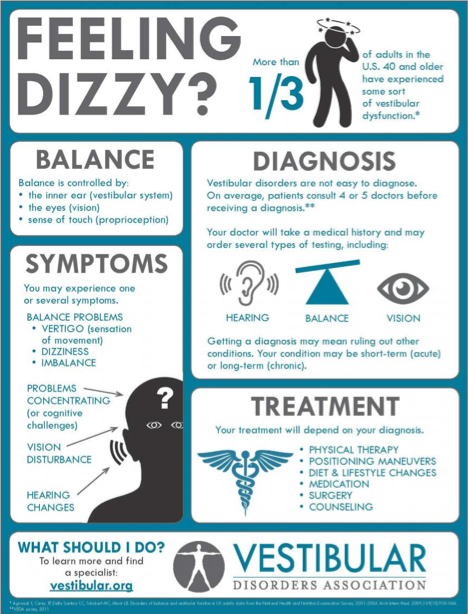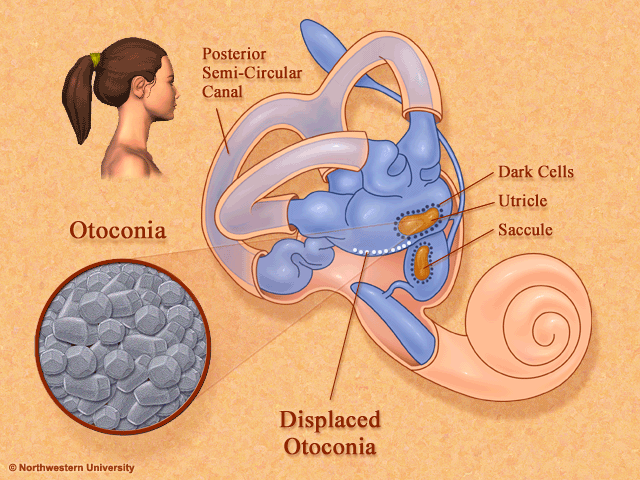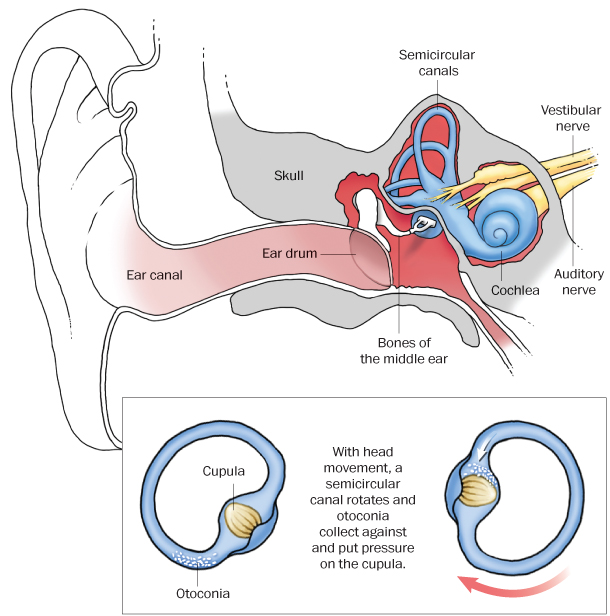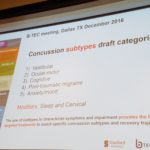Vertigo for the Concussed Population
Vertigo can occur for a wide variety of reasons. In my concussion clinic, I see vertigo approximately 60-70% of the time. As described in the photo to the right, many of these patients have been seen by other providers prior to finding their way to our clinic, and often their vertigo has been missed or treated solely with medication.
There are studies being conducted right now to determine the rates of occurrence for vertigo (BPPV) in the concussion population. It is estimated that any type of dizziness occurs in 70-80% of concussions.


Thanks to this awesome image from Northwestern University, you can see how positional changes can make the “crystals” in your inner ear move around. During a concussion, times of stress, riding on roller coasters or after an airplane ride, these crystals can move into the wrong place and cause significant dizziness and nausea. This dizziness occurs because your inner ear is telling you you are moving but your eyes are saying “NO we aren’t”! This disconnect between the eyes and the ears is what causes the spinning sensation / dizziness!
Often, patients will complain about a “room spinning dizziness”, but we have found that sometimes more vague complaints can also be effectively treated with the Epley maneuver (see below). Typically, these vague complaints would NOT be treated for vertigo! However, we have found that with this relatively easy and pain-free procedure, we are able to provide relief to patients who may not be “typical” of vertigo. Then again, when are concussed patients EVER typical??
The Epley or CRM may not work for you, but it also might, so it is almost always worth a shot! (Do NOT try this if you have an instability in your neck or compromised blood flow to your head. You can find this information out by seeking an appointment with a doctor or a vestibular therapist; often, a physical therapist).
It is important to note that there are 3 canals on each side (see above) – anterior, posterior, and lateral canals. The crystals CAN be put into any of these canals but the posterior canal is the most common and anterior is the hardest to treat at home.
Remember, you should always have a healthcare provider supervise any treatments and ensure you do not have a more serious pathology!
The lateral canal (horizontal) can be common in the concussed population. We will briefly review the treatment for this canal as well.
Most patients can help decide which side to treat simply by which direction the world spins, crackling or fullness in that ear, or crackling in their jaw. If not, you can always attempt each side and see if either makes you feel better!
You should have a reproduction of your dizziness, ear pain/fullness, or nausea when you lay back to the 1st treatment position – laying down with the head turned to the left. Your symptoms generally will increase and then slowly decrease. Wait in each position until the symptoms are completely gone + 15-30sec more. Then, move to the next position!
Expectations: Your dizziness may increase or decrease over the next 24 hours. You may experience the dizziness go away only to return in a few days. This is USUALLY ok. Try the treatment again. You may have to repeat a few times to get the vertigo to completely go away. Some people believe sleeping at a 30-45deg incline after the treatment will help it last longer. I have found that with my patients this does help. The research is mixed.
If you are having any problems and/or your dizziness isn’t going away, remember that a doctor / physical therapist will be able to evaluate you more thoroughly.
***In the photo above, the patient rests his/her head flat on the table. In the clinic, I will have the patient hang their head over the edge of the table while I am SUPPORTING their head so I can bend their neck backwards (extend) up to 30 degrees. This method IS more effective but can also be more dangerous without a full evaluation of your neck first. You may see these pictures online, but please be very careful completing the Epley this way on your own!***
I didn’t like any of the photos for the BBQ roll (treatment for horizontal canal) so I just picked the one above instead!
Steps: 1) Lay on the side that is worse when you are in bed. Stay there until your symptoms resolve + 20-30seconds. 2) Roll flat onto your back looking up at the ceiling. Stay there + 20-30sec. 3) Roll onto the opposite side. Wait + 20-30sec. 4) Keep rolling to that same side up onto your hands and knees with you head down. Wait + 20-30sec. 5) Come up into sitting.
Just like with the Epley, your dizziness may be significant when you first sit up! If all went well, this means you picked the correct canal on the correct side! Just take deep breaths and wait for the dizziness to decrease. It almost always will!
There are so many resources available online for vertigo treatments but remember that the Epley and the BBQ Roll are the only ones research really supports so they are your best bets.
Good luck and don’t be dizzy!




Comments are closed.